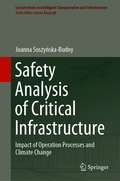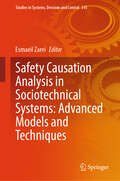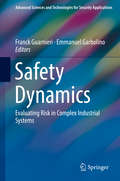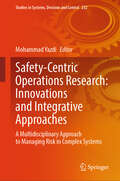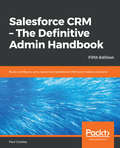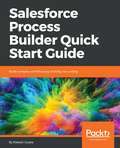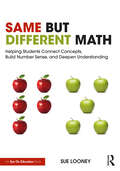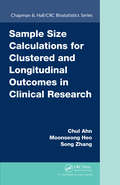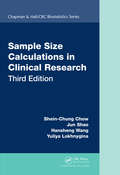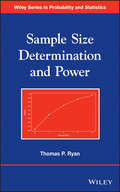- Table View
- List View
Sadlier Math, [Grade 5]
by Allan E. Bellman Catherine D. LeTourneau Jill A. PerrySadlier Math, [Grade 5]
Sadlier Math, [Grade 5], Workbook
by Allan E. Bellman Catherine D. LeTourneau Jill A. PerrySadlier Math, [Grade 5], Workbook
Sadlier Math, [Grade 6]
by Allan E. Bellman Catherine D. LeTourneau Jill A. PerrySadlier Math, [Grade 6]
Sadlier Math, [Grade 6], Workbook
by Allan E. Bellman Catherine D. LeTourneau Jill A. PerrySadlier Math, [Grade 6], Workbook
Sadlier Math, [Grade K], Volume One
by Allan E. Bellman Catherine D. LeTourneau Jill A. PerrySadlier Math, [Grade K], Volume One
Sadlier Math: [Grade 1]
by Allan E. Bellman Catherine D. LeTourneau Jill A. PerrySadlier Math, [Grade 1], Volume One
Sadlier Math: [Grade 1]
by Allan E. Bellman Catherine D. LeTourneau Jill A. PerrySadlier Math, [Grade 1], Volume Two
Sadlier Math: [Grade K]
by Allan E. Bellman Catherine D. LeTourneau Jill A. PerrySadlier Math, [Grade K], Volume Two
Safety Analysis of Critical Infrastructure: Impact of Operation Processes and Climate Change (Lecture Notes in Intelligent Transportation and Infrastructure)
by Joanna Soszyńska-BudnyThis book deals with critical infrastructure safety analysis based on reliability modelling of multistate ageing system. It shows how changes of the operation process as well as climate-weather changes in the operating area of the critical infrastructure do influence the safety parameters of its assets. Building upon previous authors’ research, the book formulates an integrated modeling approach where the multistate critical infrastructure safety model is combined with semi-Markov models for its operation process and for the climate-weather change process. This approach is shown to be successful in determining basic critical infrastructure safety, risk and resilience indicators, regardless of the number of assets and the number of their safety states. Besides the theory, the book reports on a successful application to the safety analysis of a real critical infrastructure, such as a port oil terminal. All in all, this book proposes a comprehensive and timely review of cutting-edge mathematical methods for safety identification, prediction and evaluation of critical infrastructures. It demonstrates that these methods can be applied in practice for analyzing safety of critical infrastructure under time-varying operation and climate-weather change processes.
Safety Causation Analysis in Sociotechnical Systems: Advanced Models and Techniques (Studies in Systems, Decision and Control #541)
by Esmaeil ZareiThis book provides a comprehensive view on theories, models, and techniques used to investigate and analyze incidents and safety causalities occurring in sociotechnical systems. Consisted of intricately interconnected components, sociotechnical systems are always prone to incidents. These incidents can ensue with adverse effects on employees and the public, the environment, and company's properties and reputation. Sometimes, a single incident has the potential to terminate the operation of a business forever. As incidents are multi-factorial and not easy to comprehend, they should be investigated systematically in a structured way so as to find their root causes and prevent them from recurring. Consequently, there have been developed many theories, models, and techniques aimed at accomplishing this goal. However, each approach has its own upsides and downsides, and there is no universal one applicable to all cases. Therefore, researchers and practitioners may sometimes find it difficult to select the most appropriate approach for the given case. After introducing theories, models, and techniques pertaining to incident investigation and safety causalities modeling, this book explains each one in details and discusses their pros and cons. The book aims to provide the audience with a step-by-step guidance for performing incident investigation and analysis. At the end of each chapter an example is analyzed by the introduced tool. Finally, the book offers criteria based on which an incident analysis technique can be selected.
Safety Dynamics: Evaluating Risk in Complex Industrial Systems (Advanced Sciences and Technologies for Security Applications)
by Emmanuel Garbolino Franck GuarnieriThis book describes a systematic approach to risk assessment for complex socio-technical systems like industrial processes, especially innovative ones. It provides an overview of applications of system dynamics theory and methodologies on industrial systems in order to demonstrate the relevance of such an approach in helping to assess risks in such complex systems. An important feature of this approach is that it takes into account the dynamic of the interactions of the components (technical, human and organizational ones) in order to study and simulate the behavior of the system. This methodology helps to define the failures and/or accident scenarios and to implement and test the prevention and protection barriers. This book is of particular interest to students and teachers at university level (Master and Doctorate) and to engineers interested in risk analysis and management.
Safety-Centric Operations Research: A Multidisciplinary Approach to Managing Risk in Complex Systems (Studies in Systems, Decision and Control #232)
by Mohammad YazdiThis book offers a pioneering exploration into the integration of safety considerations with operations research, providing a vital toolkit for enhancing decision-making processes in hazardous industries. It delivers comprehensive insights and innovative methodologies to foster safety-centric planning and operations across various sectors. As the complexities of modern industries increase, so does the potential for operational risks. This book addresses this challenge by merging rigorous safety analysis with the quantitative sophistication of operations research. This book aims to create safer working environments and more resilient operational frameworks. The book is divided into several key sections, each focusing on different aspects of operations research applied to safety. Initial chapters lay a theoretical foundation, discussing mathematical models and statistical methods that prioritize safety. Subsequent sections delve into specific applications within supply chain management, transportation logistics, and production planning, illustrating how these methods can be practically applied to reduce risks and enhance operational safety. Advanced topics covered include the application of machine learning and artificial intelligence to predict and mitigate potential hazards and the use of simulation techniques to model and manage operational risks. Real-world case studies are presented to show the practical implementation of these theories in industries such as manufacturing, health care, and energy, providing readers with actionable insights and proven strategies. Additionally, the book examines the cultural and behavioral aspects of safety in operations, emphasizing the importance of building a robust safety culture and integrating human factors into safety planning. Ethical and regulatory dimensions are also explored to guide practitioners in navigating the complex legal landscapes that govern safety in various industries. This book is an essential resource for students, researchers, and professionals in operations research and management, especially those involved in planning and executing operations in safety-critical sectors. It is particularly relevant for those who aim to blend technical proficiency with practical safety solutions to solve real-world challenges in operations&’ management.
Sage Beginner's Guide
by Craig FinchThis is a beginner's guide with clear step-by-step instructions, explanations, and advice. Each concept is illustrated with a complete example that you can use as a starting point for your own work. If you are an engineer, scientist, mathematician, or student, this book is for you. To get the most from Sage by using the Python programming language, we'll give you the basics of the language to get you started. For this, it will be helpful if you have some experience with basic programming concepts.
Salesforce CRM - The Definitive Admin Handbook: Build, configure, and customize Salesforce CRM and mobile solutions, 5th Edition
by Paul GoodeyA definitive guide covering all the core concepts necessary to pass the Salesforce Administrator Certification examKey FeaturesUnderstand critical design considerations for setting up Salesforce CRMFacilitate and manage the transition from Salesforce Classic to Lightning ExperienceLearn key functions of application security to manage user profiles and dataBook DescriptionSalesforce’s winter ’19 release offers a host of new features for CRM designed to meet your sales and marketing requirements. With this comprehensive guide to implementing Salesforce CRM, administrators of all levels can easily get a thorough understanding of the platform.This Salesforce handbook begins by guiding you in setting up users and security and then progresses to configuration, data management, and data analytics. You’ll discover process automation and approval mechanisms, while also exploring the functional areas of Sales Cloud, Service Cloud, Marketing Cloud, and Salesforce Chatter. This book covers Salesforce CRM system administration in a practical way, and it’ll serve as an invaluable reference for both new administrators and experienced professionals. Furthermore, you’ll also delve into Salesforce mobile apps and mobile administration, along with Salesforce Adoption Manager. You’ll gain insights into Lightning Experience, Salesforce's new app, and learn how its modern design and sleek interface helps you to build customizable components. Finally, we'll see how the two versions compare and help manage the transition from Salesforce Classic to Lightning Experience. By the end of the book, you will have mastered the techniques to configure and control various user interface features in Salesforce CRM.What you will learnConfigure a variety of user interface features in Salesforce CRMUnderstand the capabilities of the Salesforce CRM sharing modelExplore Einstein Analytics - Salesforce's new wave of advanced reporting Get to grips with the Lightning Process Builder workflowSet up user profiles, security, and login access mechanismsFind out how Apex and Visualforce coding can be used in Salesforce CRMManage the transition from Salesforce Classic to Lightning ExperienceImplement data manipulation features to apply best practices in data managementWho this book is forThis book is for administrators who want to develop and strengthen their Salesforce CRM skills in the areas of configuration and system management. Whether you are a new or experienced professional, this book will enhance your knowledge and understanding of Salesforce CRM features.
Salesforce Process Builder Quick Start Guide: Build complex workflows by clicking, not coding
by Rakesh GuptaClick your way to automating business processes with Salesforce Visual WorkflowKey FeaturesCreate and maintain complex business processes using Process builderDiscover how to debug and deploy Flow and Process BuilderUse new or existing Flows to work with Salesforce Lightning ExperienceBook DescriptionSalesforce Management System is an information system used in CRM to automate business processes, such as sales and marketing. Process Builder is a visual tool created to automate business processes in Salesforce. It enables users with no coding expertise to build complex Salesforce workflows.The book starts with an introduction to Process Builder, focussing on the building blocks of creating Processes. Then you will learn about different applications of Process Builder for developing streamlined solutions. You will learn how to easily automate business processes and tackle complex business scenarios using Processes. The book explains the workings of the Process Builder so that you can create reusable processes. It also explains how you can migrate existing Workflow Rules to Process Builder.By the end of the book, you will have a clear understanding of how to use Flows and Process Builder to optimize code usage.What you will learnDevelop an application using point and click with the help of Process BuilderBypass Processes for specific usersUnderstand the concepts of reusable processesHandle complex business processes using Process Builder and keep them cleanWork with formulae in Process Builder to minimize the code requiredCreate a process with no criteria so as to minimize the amount of reworkOvercome Salesforce's known limitation in terms of referencing picklist valuesWho this book is forThis book is for people who want to use Process Builder to automate their business requirements by clicking, not coding. A basic understanding of Salesforce is required, but not extensive programming knowledge.
Same But Different Math: Helping Students Connect Concepts, Build Number Sense, and Deepen Understanding
by Sue LooneySame But Different Math is a powerful routine to help students improve their mathematical reasoning, clarify concepts and make critical connections between ideas. Popular math consultant Sue Looney takes you step by step through implementation so you can easily add this routine into your toolbox. She establishes the rationale for the routine and then walks you through specific examples of when to use it, how to use it and how to make specific connections for learners. Throughout the book, you’ll find examples of lessons with images from a range of grade levels and mathematical content to show you the routine in action. There are also exercises for you to complete while reading to help you apply what you’ve learned, as well as a handy planning section with a template and resource links. In addition, there are Appendices featuring additional examples, which you can download from our website www.routledge.com/9781032126555 for classroom use. With the helpful features in this book, you’ll come away confidently able to implement this routine, bringing all your students to deeper levels of understanding in math.
Same-Sex Families and Legal Recognition in Europe (European Studies of Population #24)
by Marie DigoixThis open access book focuses on family diversity from a legal, demographical and sociological perspective. It investigates what is at stake in the life of homosexuals in the field of family formation, parenting and parenthood, what it brings to everyday life, the support of the law, and what its absence implies. The book shows the paths leading to the adoption of laws while demographic analyses concentrate on the link between registration of same-sex marriages and same-sex parenting with a detailed focus on Spain. The sociological chapters in this book, based upon qualitative surveys in France, Iceland and Italy, underline how the importance of the legal structure influenced the daily life of homosexual families. As such this book is an interesting read to lawyers, demographers, sociologists, behavioural scientists, and all those working in the field.
Sample Hindi Math
by Test FileThis is a test file to demonstrate the conversion of MathML to Word and Daisy with Images files.
Sample Size Calculations for Clustered and Longitudinal Outcomes in Clinical Research (Chapman & Hall/CRC Biostatistics Series #71)
by Song Zhang Chul Ahn Moonseoung HeoAccurate sample size calculation ensures that clinical studies have adequate power to detect clinically meaningful effects. This results in the efficient use of resources and avoids exposing a disproportionate number of patients to experimental treatments caused by an overpowered study. Sample Size Calculations for Clustered and Longitudinal Outcom
Sample Size Calculations in Clinical Research (Chapman & Hall/CRC Biostatistics Series)
by Shein-Chung Chow Jun Shao Hansheng Wang Yuliya LokhnyginaPraise for the Second Edition: "… this is a useful, comprehensive compendium of almost every possible sample size formula. The strong organization and carefully defined formulae will aid any researcher designing a study." -Biometrics "This impressive book contains formulae for computing sample size in a wide range of settings. One-sample studies and two-sample comparisons for quantitative, binary, and time-to-event outcomes are covered comprehensively, with separate sample size formulae for testing equality, non-inferiority, and equivalence. Many less familiar topics are also covered …" – Journal of the Royal Statistical Society Sample Size Calculations in Clinical Research, Third Edition presents statistical procedures for performing sample size calculations during various phases of clinical research and development. A comprehensive and unified presentation of statistical concepts and practical applications, this book includes a well-balanced summary of current and emerging clinical issues, regulatory requirements, and recently developed statistical methodologies for sample size calculation. Features: Compares the relative merits and disadvantages of statistical methods for sample size calculations Explains how the formulae and procedures for sample size calculations can be used in a variety of clinical research and development stages Presents real-world examples from several therapeutic areas, including cardiovascular medicine, the central nervous system, anti-infective medicine, oncology, and women’s health Provides sample size calculations for dose response studies, microarray studies, and Bayesian approaches This new edition is updated throughout, includes many new sections, and five new chapters on emerging topics: two stage seamless adaptive designs, cluster randomized trial design, zero-inflated Poisson distribution, clinical trials with extremely low incidence rates, and clinical trial simulation.
Sample Size Choice: Charts for Experiments with Linear Models, Second Edition
by Robert E. Odeh Martin FoxA guide to testing statistical hypotheses for readers familiar with the Neyman-Pearson theory of hypothesis testing including the notion of power, the general linear hypothesis (multiple regression) problem, and the special case of analysis of variance. The second edition (date of first not mentione
Sample Size Determination and Power
by Thomas P. RyanA comprehensive approach to sample size determination and power with applications for a variety of fieldsSample Size Determination and Power features a modern introduction to the applicability of sample size determination and provides a variety of discussions on broad topics including epidemiology, microarrays, survival analysis and reliability, design of experiments, regression, and confidence intervals.The book distinctively merges applications from numerous fields such as statistics, biostatistics, the health sciences, and engineering in order to provide a complete introduction to the general statistical use of sample size determination. Advanced topics including multivariate analysis, clinical trials, and quality improvement are addressed, and in addition, the book provides considerable guidance on available software for sample size determination. Written by a well-known author who has extensively class-tested the material, Sample Size Determination and Power: Highlights the applicability of sample size determination and provides extensive literature coveragePresents a modern, general approach to relevant software to guide sample size determination including CATD (computer-aided trial design)Addresses the use of sample size determination in grant proposals and provides up-to-date references for grant investigatorsAn appealing reference book for scientific researchers in a variety of fields, such as statistics, biostatistics, the health sciences, mathematics, ecology, and geology, who use sampling and estimation methods in their work, Sample Size Determination and Power is also an ideal supplementary text for upper-level undergraduate and graduate-level courses in statistical sampling.

